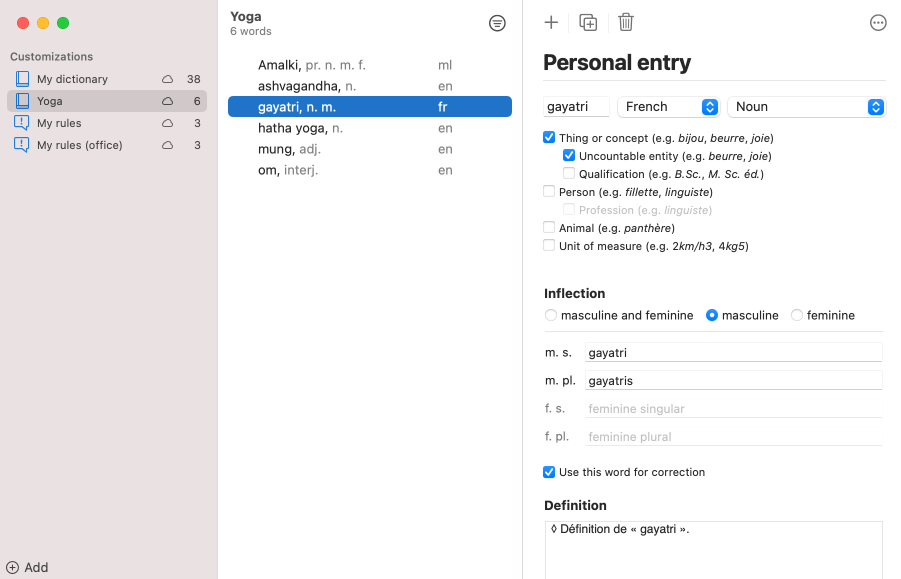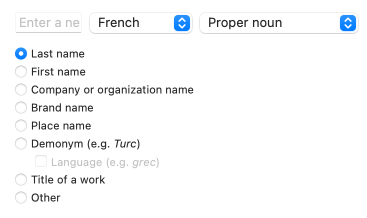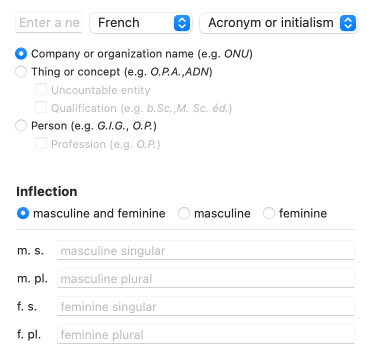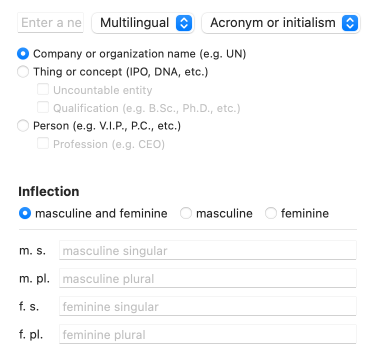French Personal Dictionaries
Introduction
You can add all the French words not recognized by Antidote – little-known proper nouns, neologisms or infrequent technical terms, various acronyms and abbreviations – to your personal dictionaries, either as specifically French entries (usable only within French texts) or as multilingual entries (usable in both French and English texts).
For a description of how the personal dictionaries applicable to both languages function, see the Personal dictionaries chapter. Here, we describe only the features that are particular to French personal dictionaries.

Filtering entries by language
The icon displays all entries, regardless of language. The All option displays all entries regardless of their language. The French option displays entries marked as French or multilingual. The English option displays entries marked as English or multilingual. The last column in the list of entries identifies the language of each entry and lets you sort them according to the three possibilities: English (en), French (fr) and multilingual (ml).
Adding a French entry
You add a new French term to the personal dictionaries in the same way as you do an English term, i.e. by typing its uninflected form (the masculine singular for a noun or adjective, the infinitive for a verb) in the headword field. However, you need to identify the language of the new word in the language menu: French, English or Multilingual. For each of these, there are different options in the categories menu, located to the right of the language menu. For French, the possible categories are noun, adjective, interjection, adverb, Latin expression, proper noun, acronym or initialism, verb and prefix.
Adding a noun

When you identify a word to be added to the personal dictionaries as a common noun, Antidote requires that you check or uncheck the boxes corresponding to the following properties: does the noun represent a thing or a concept (e.g. bijou, beurre, joie) and, if so, is it an uncountable entity (e.g. beurre, joie), or a qualification (e.g. B.Sc.)? Does the new noun designate a person (e.g. fillette) and, if so, does it correspond to a profession (e.g. linguiste)? Does it designate an animal (e.g. panthère)? The Inflection zone indicates the gender of the noun and its singular and plural forms. (Antidote inserts the expected forms for these.)
In the Definition zone, you can then add your own definition of the noun, as you can for new words of all categories. Finally, when the Use this word for correction option is checked, Antidote will use the word and the information in its entry in the corrector’s analysis. (This is the default option; unchecking it would exclude the word.)
Adding an adjective

When entering a new word as an adjective, you are asked to indicate whether the word can also be used to designate a resident (e.g. Belge), as well as a spoken language (e.g. grec).
Adding an interjection

When entering a new word as an interjection, you are asked to specify whether it corresponds to an emotional reaction (e.g. zut!), a message to others (e.g. allo) or a noise (e.g. dring).
Adding an adverb

When adding a new word as an adverb, you are asked to specify whether it is an adverb of manner (e.g. poliment), time (e.g. aujourd’hui) or place (e.g. partout).
Adding a proper noun

When adding a new word as a proper noun, you are asked to indicate whether it is a last name, a first name, the name of a company or an organization, a brand name, a place name, a demonym as well as the name of a language, the title of a work, or, finally, whether the proper noun belongs to some other category.
Adding an acronym or initialism

When adding a new word as an acronym or initialism, you are asked to specify whether it is the name of a company or organization (e.g. ONU), a thing or a concept (e.g. O.P.A., ADN) or a person (e.g. G.I.G., O.P.) and, if so, whether it designates a profession (e.g. O.P.). The Inflection zone indicates the inflected forms of the word in the masculine and feminine, singular and plural (the expected forms are displayed by default).
Adding a verb

When entering a new word as a verb, you are asked to indicate how it conjugates. Here, you are given four verbal models to choose from: verbs ending in –er, like aimer; verbs ending in –ir, like finir, whose third-person imperfect form is –issait; verbs ending in –ir, like courir, which form the imparfait in regular fashion; and verbs ending in –re, like rendre.
Adding a prefix
When adding a new word as a prefix, you are asked to indicate whether it must be followed by a hyphen, whether it never requires a hyphen, or whether the hyphen is optional, and this, for both its traditional and rectified spellings.
Adding a translation
For a new word either in English or in French, you can add a translation by clicking the button in the toolbar at the bottom of the Translations panel. As soon as you start typing in a text field, Antidote will suggest words to use. Select the most suitable suggestion or suggestions.
- In order to add a translation, it must be recognized by Antidote. If this is not the case, you must create an entry in your personal dictionaries.
Adding a multilingual entry
Because proper nouns and acronyms are often identical in English and French, the personal dictionaries let you add “multilingual” entries, in order to avoid having to enter them separately in each language.
Adding a multilingual proper noun

When adding a new word as a multilingual proper noun, you are asked to identify the same properties as for an English or French proper noun (i.e. last name, first name, company name, etc.). In the Inflection zone, you indicate the masculine, feminine or gender-neutral forms of the word. Finally, a drop-down menu added to the top-right corner of the Definition zone allows you to add both a French definition (◊ Définition de “Gourmaison”.) and an English one (◊ Definition of “Gourmaison”.).
Adding a multilingual initialism or acronym

When adding a new word as a multilingual initialism or acronym, you are asked to identify the same properties as for their monolingual counterparts (i.e. company name, thing or concept, person). In the Inflection zone, you indicate the masculine, feminine or gender-neutral forms of the word. Finally, the same French/English language menu is added to the Definition zone.
Note — For more information on personal dictionaries, see the Personal Dictionaries section.